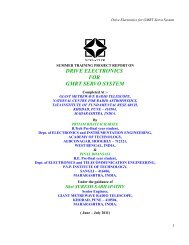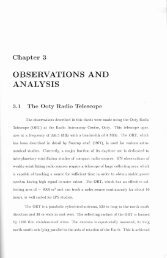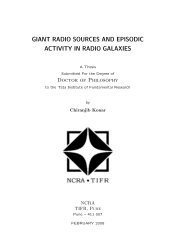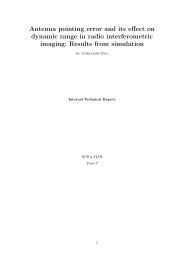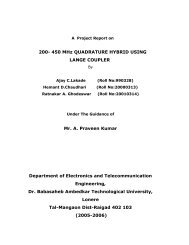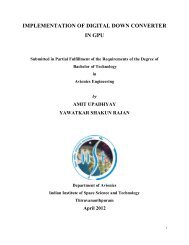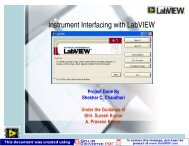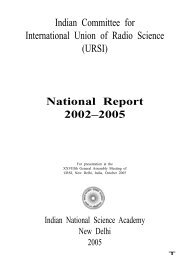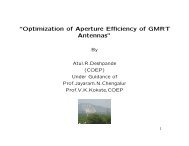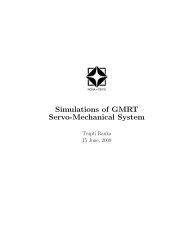modeling of brushless drive motor controller for gmrt
modeling of brushless drive motor controller for gmrt
modeling of brushless drive motor controller for gmrt
Create successful ePaper yourself
Turn your PDF publications into a flip-book with our unique Google optimized e-Paper software.
MODELING OF BRUSHLESS DRIVE MOTORCONTROLLER FOR GMRTSubmitted in Partial Fulfillment <strong>of</strong> the Requirements <strong>for</strong> the Degree <strong>of</strong>Bachelor <strong>of</strong> TechnologyinAvionicsbyVIVEK KUMAR(SC08B080)Department <strong>of</strong> AvionicsIndian Institute <strong>of</strong> Space Science and TechnologyThiruvananthapuramMay 2012
Declaration by AuthorThis is to declare that this report has been written by me. No part <strong>of</strong> thereport is plagiarized from other sources. All in<strong>for</strong>mation included from othersources has been duly acknowledged. I aver that if any part <strong>of</strong> the report isfound to be plagiarized, I shall take full responsibility <strong>for</strong> it.VIVEK KUMARSC08B080PlaceDate
ACKNOWLEDGEMENTThe satisfaction that accompanies the successful completion <strong>of</strong> any task would be incompletewithout the mention <strong>of</strong> people who made it possible and whose constant encouragement andguidance has been a source <strong>of</strong> inspiration throughout the course <strong>of</strong> this project.I express my sincere thanks to our Director Dr. K.S.Dasgupta, Mrs. Sheebarani Ph.D., AssistantPr<strong>of</strong>essor, Avionics at IIST, Mrs. Anandamayee Tej, Ph.D., Assistant Pr<strong>of</strong>essor, PhysicalSciences at IIST <strong>for</strong> providing such a great opportunity to work on the project.I thank Mr. Suresh Sabhapathy, Engineer-‗F‘ , GMRT, Khodad, Pune <strong>for</strong> the excellent guidancehe has provided in completing this project.I also express our pr<strong>of</strong>ound gratitude to Dr. Selvaganeshan, Ph.D., Assistant Pr<strong>of</strong>essor, Avionicsat IIST <strong>for</strong> his sincere supervision and encouragement.Finally and most importantly I thank the almighty <strong>for</strong> all this success.
ABSTRACTThis project discusses the <strong>modeling</strong> <strong>of</strong> the PMAC (Programmable Multi Axis Controller) as a<strong>controller</strong> <strong>for</strong> the <strong>brushless</strong> <strong>drive</strong> servo <strong>motor</strong>, which is replacing the brushed <strong>motor</strong>s in most <strong>of</strong>the industries and facilities including GMRT (Giant Metrewave Radio Telescope). It givesdetails <strong>of</strong> the mathematical model <strong>of</strong> a Permanent Magnet DC Motor, and then that <strong>of</strong> aBrushless Motor. The s<strong>of</strong>tware tool used <strong>for</strong> <strong>modeling</strong> and analysis is Matlab/Simulink. Thisproject also discusses the advantages <strong>of</strong> the Brushless Motor over conventional <strong>motor</strong>s. Theproject gives details <strong>of</strong> the PID servo filter which is sufficient to control the system. It is this PIDservo filter that is modeled as the <strong>controller</strong> (PMAC). Finally this <strong>controller</strong> model isimplemented in the system with the <strong>motor</strong> model, and the overall system response is obtainedand analyzed.
ContentsABSTRACTLIST OF FIGURES1 INTRODUCTION ................................................................................................................................ 91.1 BRIEF ABOUT GMRT ................................................................................................................ 91.2 IMPORTANCE OF THE PROBLEM ........................................................................................ 101.3 SCOPE OF THE PROJECT ....................................................................................................... 112 WORK DESCRIPTION: APPROACH USED ................................................................................... 122.1 SOFTWARE TOOL USED ............................................................................................................... 122.2 SCIENTIFIC MODELING ......................................................................................................... 122.3 MOTOR ...................................................................................................................................... 132.4 MOTOR MODEL ....................................................................................................................... 142.4.1 BRUSH DC MOTOR ......................................................................................................... 142.4.2 BRUSHLESS DRIVE MOTOR ......................................................................................... 172.5 CONTROL .................................................................................................................................. 202.5.1 PMAC ................................................................................................................................. 212.5.2 PMAC PID FILTER ........................................................................................................... 263 MODELING AND SIMULATIONS .................................................................................................. 293.1 IMPORTANT FEATURES AND STEPS .................................................................................. 293.2 SYSTEM MODELING: TRANSFER FUNCTION ................................................................... 293.3 SIMULATIONS ......................................................................................................................... 323.3.1 MOTOR MODELS ............................................................................................................. 323.3.2 SYSTEM MODEL .............................................................................................................. 374 RESULTS AND DISCUSSION ......................................................................................................... 404.1 SYSTEM RESPONSE ................................................................................................................ 404.2 PID VALUES PUBLISHED ...................................................................................................... 425 CONCLUSIONS ................................................................................................................................. 436 RECOMMENDATIONS .................................................................................................................... 437 APPENDICES .................................................................................................................................... 448 REFERENCES ................................................................................................................................... 48
LIST OF FIGURESFigure 1-1 GMRT Antenna Array .............................................................................................................. 10Figure 2-1 AKM MOTORS DATASHEET ............................................................................................... 13Figure 2-2 DC Motor Block Diagram ......................................................................................................... 14Figure 2-3 DC Motor Electromechanical Arrangement .............................................................................. 14Figure 2-4 A Brushless Motor Electromechanical Arrangement ................................................................ 18Figure 2-5 A simple Control System Involving Antenna Positioning ........................................................ 20Figure 2-6 A System with PID Control ...................................................................................................... 24Figure 2-7 Diagram <strong>for</strong> PMAC PID Servo Loop Filter .............................................................................. 26Figure 3-1DC Motor Simulink Model ........................................................................................................ 32Figure 3-2 a DC Motor Angular Rate: Step Voltage Applied .................................................................... 32Figure 3-3 <strong>brushless</strong> <strong>motor</strong> step response ................................................................................................... 35Figure 3-4 Brushless Motor Open Loop Bode ............................................................................................ 36Figure 3-5 Motor with PID <strong>controller</strong> ......................................................................................................... 36Figure 3-6 Simulink PID Block GUI .......................................................................................................... 37Figure 3-7 Model <strong>of</strong> the PMAC Controller + Motor .................................................................................. 37Figure 3-8 PMAC: The Controller Model .................................................................................................. 38Figure 3-9 Motor and Amplifier Modeled .................................................................................................. 39Figure 4-1 Step Response <strong>of</strong> the system model .......................................................................................... 40Figure 4-2 Step Response with no Random Noise Added to the Motor ..................................................... 41Figure 4-3 Step Response with Amplifier Dynamics Removed ................................................................. 42
1 INTRODUCTION1.1 BRIEF ABOUT GMRTGiant Metrewave Radio Telescope (GMRT) is located at Khodad, 80 km north from Pune inIndia. It is the world‘s largest array <strong>of</strong> radio telescope at meter wavelength. It is operated byNational Centre <strong>for</strong> Radio Astrophysics (NCRA), a part <strong>of</strong> Tata Institute <strong>of</strong> FundamentalResearch (TIFR), Mumbai. A nearby town is Narayangaon on Pune – Nasik highway, 15 kmfrom GMRT. GMRT consists <strong>of</strong> 30 fully steerable giant parabolic dishes <strong>of</strong> 45m diameter eachspread over distance <strong>of</strong> up to 25km. This is a unique setup <strong>for</strong> astronomical research usingmetrewave length range <strong>of</strong> radio spectrum. At high frequencies the study <strong>of</strong> universe can easilybe done. But in so high frequency RF noise is also high in other countries, but in India this RFnoise level is comparatively low.There are 14 antennas randomly arranged in the central square, with a further 16 arranged in 3arms <strong>of</strong> the nearly ―Y‖ shaped array giving an in<strong>for</strong>mating baseline <strong>of</strong> about 25km. GMRT is aninterferometer, uses a technique known as aperture synthesis to make image <strong>of</strong> radio sources.Each antenna is <strong>of</strong> 45m diameter and consists <strong>of</strong> a solid surface like many radio telescopes; thereflector is made <strong>of</strong> wire rope stretched between metal struts in parabolic configuration. Eachantenna has 4 different receivers mounted at the focus. Each individual receiver can rotate so thatthe user can select the frequency at which to observe. The array operated in six frequency bandscentered on 50, 153, 233, 325, 610 and 1420 MHz. All these feeds provide dual polarizationoutput. The construction <strong>of</strong> 30 large dishes at a relatively small cost has been possible due to animportant technological breakthrough achieved by Indian Scientists and Engineers in the design<strong>of</strong> lightweight, low cost dishes. The design is based on what is being called the `SMART‘concept <strong>for</strong> Stretch Mesh Attached to Rope Trusses.
Figure 1-1 GMRT Antenna Array1.2 IMPORTANCE OF THE PROBLEMIn GMRT there are total 30 antennas and each antenna consists <strong>of</strong> four servo <strong>motor</strong>s, two <strong>for</strong>azimuth operation and two <strong>for</strong> elevation operation. Thus there are total 120 servo<strong>motor</strong>s. Earlier,these were all brushed <strong>motor</strong>s. Brushes wear out due to constant contact during rotation betweenstator and rotor <strong>of</strong> these <strong>motor</strong>s. Carbon powder gathers in between stator and rotor. Thuscommutator segments might get shorted due to the burned carbon participated in between whichmight result in unbalancing <strong>of</strong> <strong>motor</strong> operation. Thus DC <strong>motor</strong> requires a periodic maintenanceto prevent it from permanent damage. Thus in case <strong>of</strong> GMRT where a large number <strong>of</strong> theseservo <strong>motor</strong>s are used and they work constantly as GMRT is 24×7 observatory, it is a hugeproblem <strong>for</strong> maintenance all these 120 antennas periodically. This is costly as well as it takes alarge time. GMRT antennas have 45m diameter and they observes the universe like Jupiter, Sun,Pulsar, and X rays sources. It also observes the near Galaxies, Supernova and cluster <strong>of</strong> galaxiesat very high Radio Frequency ranges. These antennas specify <strong>for</strong> the ranges 40 – 1700 MHz. But
in such high frequency noise level also creates problem <strong>for</strong> these brushed <strong>motor</strong>s. In case <strong>of</strong><strong>brushless</strong> <strong>motor</strong> the RFI can be eliminated.Due to these reasons, GMRT has been replacing the brushed <strong>motor</strong>s with the <strong>brushless</strong> servo<strong>motor</strong>s. A model <strong>for</strong> these <strong>motor</strong>s can there<strong>for</strong>e be used to easily see the improvements achievedwith this decision, as well as to study and analyze several aspects that need an immediateattention. For accurate and efficient positioning and tracking <strong>of</strong> the GMRT antennas, a highper<strong>for</strong>manceservo motion <strong>controller</strong> capable <strong>of</strong> commanding multiple axes <strong>of</strong> motion with ahigh level <strong>of</strong> sophistication is used. Such a device is PMAC. For an overall understanding <strong>of</strong> thecontrol action <strong>of</strong> the PMAC, and to see how the <strong>controller</strong> improves the attributes <strong>of</strong> the <strong>motor</strong>, amodel based approach is appropriate.1.3 SCOPE OF THE PROJECTThe project takes a model based approach <strong>for</strong> the understanding <strong>of</strong> a problem. There is moreemphasis on the mathematical <strong>modeling</strong> <strong>of</strong> the Motor <strong>for</strong> obtaining the transfer function ratherthan going into deep details <strong>of</strong> its construction and working. Mathematical models <strong>for</strong> a DCBrushed Motor and a Brushless Motor is achieved and implemented in Matlab/Simulink <strong>for</strong>study. The <strong>brushless</strong> <strong>motor</strong> used at GMRT is implemented in the model obtained. It is required tomodel the <strong>controller</strong> that PMAC provides <strong>for</strong> position control, and implement it inMatlab/Simulink with the <strong>motor</strong> model using the experimental data provided. Finally, the systemresponse is obtained and analyzed.
2 WORK DESCRIPTION: APPROACH USED2.1 SOFTWARE TOOL USEDMATLAB and SIMULINKMATLAB is a high-per<strong>for</strong>mance language <strong>for</strong> technical computing. It integrates computation,visualization, and programming in an easy-to-use environment where problems and solutions areexpressed in familiar mathematical notation. Typical uses include:• Math and computation• Algorithm development• Data acquisition• Modeling, simulation, and prototyping• Data analysis, exploration, and visualization• Scientific and engineering graphics• Application development, including graphical user interface buildingThe name MATLAB stands <strong>for</strong> Matrix Laboratory.SIMULINK is s<strong>of</strong>tware <strong>for</strong> <strong>modeling</strong>, simulating, and analyzing dynamic systems. Simulinkenables you to pose a question about a system, model it, and see what happens.2.2 SCIENTIFIC MODELING Modeling as a substitute <strong>for</strong> direct measurement and experimentation Simulation: Implementation <strong>of</strong> a model Structure: Different elements and entities Systems: Construct or collection <strong>of</strong> different elements and entities Process <strong>of</strong> generating a model: As a conceptual representation <strong>of</strong> some phenomenon Process <strong>of</strong> evaluating a model: Ability to explain past observations, predict futureobservations, and simplicity
Visualization: any technique <strong>of</strong> creating images, diagrams or animations to communicatea message2.3 MOTORAn electric <strong>motor</strong> is a machine which converts electric energy into mechanical energy. Its actionis based on the current carrying conductor placed in magnetic field.The BLDC <strong>motor</strong> used in the project <strong>for</strong> <strong>modeling</strong> purposes is:KOLLMORGEN, ID.BL MOTOR – 3-PHASE PM SERVOMOTORMODEL: AKM73M – KSC2R – 02Figure 2-1 AKM MOTORS DATASHEET
2.4 MOTOR MODEL2.4.1 BRUSH DC MOTORMathematical Model:Figure 2-2 DC Motor Block DiagramFigure 2-3 DC Motor Electromechanical ArrangementTable 2-1 Electromechanical ParametersLRBmJKeKtTωArmature InductanceArmature ResistanceViscous Friction ConstantRotor InertiaBack emf ConstantTorque ConstantElectric TorqueAngular Rate
Applying KVL:Eq. 2-1Eq. 2-2There<strong>for</strong>e,Eq. 2-3Also, <strong>for</strong> no load, Electric Torque can be expressed asEq. 2-4This gives,Eq. 2-5Also,Eq. 2-6Applying Laplace Trans<strong>for</strong>m to the differential equations, we getEq. 2-7Eq. 2-8This gives,Eq. 2-9Putting this value <strong>of</strong> current in Eq. 2-7, we get. / ( ) Eq. 2-10
Or, solving this results toEq. 2-11This is the required transfer function <strong>of</strong> a conventional DC Motor.Ideal Condition Analysis and Approximations: Time ConstantsConsider a DC Motor with no Load torque and negligible viscous damping when the rotorrotates. There<strong>for</strong>e,Eq. 2-12Thus, the transfer function becomes:Eq. 2-13Now, by multiplying the numerator and denominator bywe get⁄Eq. 2-14Now, define:Where and are Mechanical Time Constant and Electrical Time Constant respectively.Thus the transfer function <strong>of</strong> DC Motor is⁄
2.4.2 BRUSHLESS DRIVE MOTOR2.4.2.1 MAIN FEATURES It can be envisioned as a brush DC <strong>motor</strong> turned inside out, where the permanent magnetsare on the rotor, and windings on the stator. As a result, there are no mechanical brushes and commutators in this <strong>motor</strong>. There is no physical contact between the rotor and the stator. The <strong>motor</strong> is referred to as a ―DC <strong>motor</strong>‖ because its coils are <strong>drive</strong>n by a DC powersource which is applied to the various stator coils in a predetermined sequential pattern:process known as commutation. The name ―BLDC‖ is actually a misnomer, <strong>motor</strong> being effectively an AC <strong>motor</strong>: currentin each coil alternates during each electrical cycle. How it is <strong>drive</strong>n: in a BLDC, which stator coil is <strong>drive</strong>n is determined by the rotorposition. So, the knowledge <strong>of</strong> the rotor position is required to determine which statorcoils to energize.2.4.2.2 ADVANTAGES OVER CONVENTIONAL MOTORS More efficient, much cooler. There is no mechanical commutation to wear out. There is very less chance <strong>of</strong> sparking, unlike brushed <strong>motor</strong>s, making them better suitedto environments with volatile chemicals and fuels. Acoustically very quiet <strong>motor</strong>s. Long operating life. High dynamic response. Better speed vs. torque characteristics. Higher torque – weight ratio. Higher speed range.
2.4.2.3 MATHEMATICAL MODELINGTypically, the mathematical model <strong>of</strong> a <strong>brushless</strong> <strong>motor</strong> is not totally different from theconventional DC <strong>motor</strong>. The major thing added is the phases involved which affects the overallresults <strong>of</strong> the BLDC <strong>motor</strong>. The phases peculiarly affect the resistive and the inductive <strong>of</strong> theBLDC arrangement. For example, a simple arrangement with a symmetrical 3-phase and ―wye‖internal connection could give a brief illustration <strong>of</strong> the whole phase concept.Figure 2-4 A Brushless Motor Electromechanical ArrangementThe mechanical and electrical time constants <strong>for</strong> a <strong>brushless</strong> <strong>motor</strong> have the same basic equationsas the conventional DC <strong>motor</strong>s with some variations.The mechanical time constant is∑The electrical time constant isNow,∑Eq. 2-15Since, this is a symmetrical arrangement, i.e. R1=R2=R3=RThere<strong>for</strong>e,
∑ Eq. 2-16Hence, the mechanical time constant <strong>for</strong> this example <strong>of</strong> <strong>brushless</strong> <strong>motor</strong> isAnd the electrical time constant isPutting this in the transfer function derived <strong>for</strong> a DC <strong>motor</strong>:⁄Eq. 2-17We get the transfer function <strong>of</strong> a <strong>brushless</strong> <strong>motor</strong>:⁄Eq. 2-18This result obtained is implemented in Matlab to study the <strong>brushless</strong> <strong>motor</strong> open loopcharacteristics, and the open loop transient and frequency responses. In practical applications or<strong>for</strong> the <strong>modeling</strong> purposes, the viscous friction can‘t be neglected. Hence, the <strong>motor</strong> model isimplemented in Matlab/Simulink with added viscous friction dynamics, and the response andcharacteristics are analyzed, and compared to the ideal scenario.Further, the <strong>motor</strong> is modeled and improved with the use <strong>of</strong> PID <strong>controller</strong> toolbox, a SimulinkToolbox and GUI application to study and understand the effects <strong>of</strong> P, I and D gains be<strong>for</strong>eimplementing it with the PMAC PID filter <strong>controller</strong> model.
2.5 CONTROLA Controller is a device which monitors and affects the operational conditions <strong>of</strong> a dynamicsystem. It serves to govern in some predetermined manner the per<strong>for</strong>mance <strong>of</strong> an entity or adevice, such as an electric <strong>motor</strong>. When one or more output variables <strong>of</strong> a system need to followa certain reference over time, the <strong>controller</strong> manipulates the inputs to a system to obtain thedesired effect on the output <strong>of</strong> the system. Control has four functions: Measure, Compare,Compute and Correct.At GMRT, there are 30 antennas and each antenna consists <strong>of</strong> 4 servo<strong>motor</strong>s. This project aimsat <strong>modeling</strong> the <strong>controller</strong> that can be used <strong>for</strong> position control <strong>for</strong> at least one <strong>motor</strong> to positionthe antenna in a desired direction. The following figure gives a general idea <strong>of</strong> the feedbackcontrol system where the <strong>controller</strong> positions the antenna by giving a controlled signal to the<strong>motor</strong>:Figure 2-5 A simple Control System Involving Antenna PositioningThe antennas at GMRT need to be regularly synchronized with each other, and they need to beaccurately positioned and to be able to track an object in the sky. This sort <strong>of</strong> positioning andtracking requires <strong>controller</strong> with a high level <strong>of</strong> accuracy and sophistication, and the motioncontrol need to be done <strong>for</strong> several axes. Such a <strong>controller</strong> is PMAC.
2.5.1 PMACPMAC stands <strong>for</strong> Programmable Multi-Axis Controller. The Delta Tau Data Systems, Inc.Programmable Multi-Axis Controller (PMAC) is a family <strong>of</strong> high per<strong>for</strong>mance servo motion<strong>controller</strong>s capable <strong>of</strong> commanding up to eight axes <strong>of</strong> motion simultaneously with a high level<strong>of</strong> sophistication. Through the power <strong>of</strong> a Digital Signal Processor (DSP), PMAC <strong>of</strong>fers a priceper<strong>for</strong>manceratio <strong>for</strong> multi-axis control that was not previously available. Motorola‘s DSP56001is the CPU <strong>for</strong> PMAC, and it handles all the calculations <strong>for</strong> all eight axes. There are fourhardware versions <strong>of</strong> PMAC: the PMAC-PC, the PMAC-Lite, the PMAC-VME, and the PMAC-STD. These cards differ from each other in their <strong>for</strong>m factor, the nature <strong>of</strong> the bus interface, andin the availability <strong>of</strong> certain I/O ports. All versions <strong>of</strong> the card have identical on-board firmware,so PMAC programs written <strong>for</strong> one version will run on any other version. The PMAC-STD has adifferent memory mapping <strong>of</strong> some I/O. Any version <strong>of</strong> PMAC may run as a standalone<strong>controller</strong>, or it may be commanded by a host computer, either over a serial port or over a busport.The Universal PMAC-Lite board, member <strong>of</strong> the PMAC family, is a 4-axis motion <strong>controller</strong>.The term ―Lite‖ stands to indicate a maximum <strong>of</strong> four on-board axes <strong>of</strong> motion control. The term―Universal‖ indicates that this motion <strong>controller</strong> can have different types <strong>of</strong> on-board backupmemory, either battery based type or flash type. Each axis is controlled by an independentchannel circuitry, which in turn is composed <strong>of</strong> the following features:A single differential 16-bits DAC outputAmplifier enable outputOne quadrature incremental encoder inputFour dedicated flag inputs: two end-<strong>of</strong>-travel limits, one home input and one amplifierfault inputThe Universal PMAC-Lite can be programmed to control the motion <strong>of</strong> up to four <strong>motor</strong>s in anycoordinated fashion, either independently <strong>of</strong> each other or coordinated with, <strong>for</strong> example, linearor circular interpolation. The Universal PMAC-Lite is not only a very sophisticated motion<strong>controller</strong> but it is also a PLC, Programmable Logic Controller device. PLC programs in PMACrun conveniently independently <strong>of</strong> each other and <strong>of</strong> motion programs and can be very tightlysynchronized to the motion sequence. PMAC has its own on-board memory. Programs and
motion parameters can be kept in memory without the need to reprogram each time PMAC ispower up.2.5.1.1 PMAC SOFTWARE SETUP• I – variables (Initialization Parameters)• P – variables• M – variables• Q – variablesWe are mostly concerned with some <strong>of</strong> the I-variables which are required in the <strong>controller</strong>model.2.5.1.2 PMAC FEATURES: TASKS IN PRIORITY Executing Motion Programs: The most obvious task <strong>of</strong> PMAC is executing sequences <strong>of</strong>motions given to it in a motion program. When told to execute a motion program, PMACworks through the program one move at a time, per<strong>for</strong>ming all the calculations up to thatmove command (including non-motion tasks) to prepare <strong>for</strong> actual execution <strong>of</strong> themove. PMAC is always working ahead <strong>of</strong> the actual move in progress, so it can blendproperly into the upcoming move, if required. Executing PLC Programs: The sequential nature <strong>of</strong> motion program suits it well <strong>for</strong>commanding a series <strong>of</strong> moves and other coordinated actions; however these programsare not good at per<strong>for</strong>ming actions that are not directly coordinated with the sequence <strong>of</strong>motions. For these types <strong>of</strong> tasks, PMAC provides the capability <strong>for</strong> users to write PLCprograms. These are named after Programmable Logic Controllers because they operatein a similar manner, continually scanning through their operations as fast as processortime allows. These programs are very useful <strong>for</strong> any task that is asynchronous to themotion sequences. Servo Loop Update: In an automatic task that is essentially invisible to the PMAC user,PMAC per<strong>for</strong>ms a servo update <strong>for</strong> each <strong>motor</strong> at a fixed frequency (usually around 2kHz). The servo update <strong>for</strong> a <strong>motor</strong> consists <strong>of</strong> incrementing the commanded position (ifnecessary) according the equations generated by the motion program or other motion
command, comparing this to the actual position as read from the feedback sensor, andcomputing a command output based on the difference. This task occurs automaticallywithout the need <strong>for</strong> any explicit commands.Commutation Update: If PMAC is requested to per<strong>for</strong>m the commutation <strong>for</strong> amultiphase <strong>motor</strong>, it will per<strong>for</strong>m commutation updates automatically at a fixedfrequency (usually around 9 kHz). The commutation, or phasing, update <strong>for</strong> a <strong>motor</strong>consists <strong>of</strong> measuring and/or estimating the rotor magnetic field orientation, thenapportioning the command that was calculated by the servo update among the differentphases <strong>of</strong> the <strong>motor</strong>. This task occurs automatically without the need <strong>for</strong> any explicitcommands.Housekeeping: PMAC regularly and automatically per<strong>for</strong>ms housekeeping tasks thatmake sure the system is in good working order. These tasks include the safety checks,such as following error limits, hardware overtravel limits, s<strong>of</strong>tware overtravel limits, andamplifier faults. They also include the update <strong>of</strong> the watchdog timer. If any problem inhardware or s<strong>of</strong>tware keeps these tasks from executing, the watchdog timer will trip, andthe card will shut down.Communicating With the Host: PMAC can communicate with the host at any time, evenin the middle <strong>of</strong> a sequence <strong>of</strong> motions. PMAC will accept a command, and take theappropriate action (putting the command in a program buffer <strong>for</strong> later execution),providing a data response to the host, starting a <strong>motor</strong> move, etc. If the command isillegal, it will report an error to the host.2.5.1.3 CONTROLLERThe PID Controller:The PID <strong>controller</strong> is the most common <strong>for</strong>m <strong>of</strong> feedback <strong>controller</strong>. It was an essential element<strong>of</strong> early governors and it became the standard tool when process control emerged in the 1940s. Inprocess control today, more than 95% <strong>of</strong> the control loops are <strong>of</strong> PID type, most loops areactually PI control. PID <strong>controller</strong>s are today found in all areas where control is used. The<strong>controller</strong>s come in many different <strong>for</strong>ms. There are standalone systems in boxes <strong>for</strong> one or a fewloops, which are manufactured by the hundred thousand yearly. PID control is an importantingredient <strong>of</strong> a distributed control system. The <strong>controller</strong>s are also embedded in many special
purpose control systems. PID control is <strong>of</strong>ten combined with logic, sequential functions,selectors, and simple function blocks to build the complicated automation systems used <strong>for</strong>energy production, transportation, and manufacturing. Many sophisticated control strategies,such as model predictive control, are also organized hierarchically. PID control is used at thelowest level; the multivariable <strong>controller</strong> gives the set points to the <strong>controller</strong>s at the lower level.The PID <strong>controller</strong> can thus be said to be the ―bread and butter‘‘ <strong>of</strong> control engineering. It is animportant component in every control engineer‘s tool box.Figure 2-6 A System with PID ControlSome Characteristic Effects:The proportional gain Kp will reduce the rise time and might reduce the steady state error <strong>of</strong> thesystem. The integral gain Ki will eliminate the steady state error but it might have a negativeeffect on the transient response. And the derivative gain Kd will tend to increase the stability <strong>of</strong>the system, reducing overshoot percentage, and improving the transient response <strong>of</strong> the system.In all, the following table gives the comprehensive effects <strong>of</strong> each <strong>of</strong> the <strong>controller</strong>s on a typicalclosed loop system:
Table 2-2 PID Controller Parameter Characteristics on a Typical SystemParameter Rise Time Overshoot Settling Time Steady StateErrorKp decreases increases Small change decreasesKi decreases increases increases eliminateKd Small change decreases decreases Small changeThe PMAC Controller to be modeled:The <strong>controller</strong> is a multi-axis PID <strong>controller</strong> with feed-<strong>for</strong>ward and feedback capabilities. Inorder to work within the available memory <strong>of</strong> the PMAC, and correctly deal with the differentresolutions <strong>of</strong> the encoders, scale factors are used throughout the control loop. The PMACcommand output is governed by Equation below where the n represents the time step. The outputservo command is commutated and sent to a linear differential amplifier that is tuned <strong>for</strong> eachaxis. The PMAC takes approximately 0.443ms per servo cycle which is about 2257 samples persecond which represents a loop closure rate <strong>of</strong> 2.257 kHz <strong>for</strong> control purposes. The commandoutput <strong>of</strong> the PMAC shown in Equation below is essentially a PID filter with feed-<strong>for</strong>wardterms; the variables are listed in the following table. The command output is given in encodercounts and limited to 32,767 encoder counts with a range <strong>of</strong> ±10V volts:PMAC eqn. 2-1:( ) *, ( )( ) ( ) ( )-( )+Table 2-3 Variables Listed and Their DescriptionVariable NameIx30, Ix31, Ix33Ix08, Ix09Ix32Ix35DescriptionPID respectivelyPosition and Velocity loop scale factorsFeed-<strong>for</strong>ward velocity gainFeed-<strong>for</strong>ward acceleration gain
CA(n), CV(n)FE(n), IE(n)AV(n)Command Acceleration and VelocityFollowing error and Integration errorActual Velocity2.5.2 PMAC PID FILTERFigure 2-7 Diagram <strong>for</strong> PMAC PID Servo Loop FilterThe standard PMAC <strong>controller</strong> provides a PID position loop servo filter. Usually, this filter issufficient to control the system, and easily understandable as well, even <strong>for</strong> non-controlspecialists. The filter is tuned by setting the appropriate I-variables <strong>for</strong> each <strong>motor</strong>.The proportional gain (P — Ix30) provides the stiffness <strong>of</strong> the system; the differential gain (D —Ix31) provides the damping <strong>for</strong> stability; the integral gain (I — Ix33) eliminates steady-stateerrors. Ix34 determines whether the integral gain is active all the time, or just during periodswhen the commanded velocity is zero.
In addition, velocity feed <strong>for</strong>ward gain (Ix32) reduces following errors introduced by damping(which are proportional to velocity), and acceleration feed <strong>for</strong>ward gain (Ix35) reduces oreliminates following errors due to system inertia (which are proportional to acceleration).Present Terms:Ixx30 ( Kp ) - Proportional Gain - Increasing proportional gain stiffens the servo loop andincreases the natural frequency <strong>of</strong> the closed loop system. Theoretically, increasing theproportional gain will result in improved positioning and tracking. However, <strong>of</strong>ten <strong>for</strong> realsystems increasing the proportional gain increases their sensitivity to the noise and disturbances.If skipping the auto tuning, begin tuning with the low proportional gain setting. The default valueis a very conservative value <strong>for</strong> most systems and is a good starting point.Ixx31 ( Kd ) - Derivative Gain - Derivative gain works like damper. Higher the derivative gain,higher the damping action. This gain prevents overshoot but makes the system sluggish. Also, indigital system the quantization noise is amplified when derivative gain is applied, and in slowmoving (low counts per second) system this noise might contribute significantly to the error. Ifskipping the auto tuning, it is always wise to begin the tuning with the low derivative gainsetting. Default value is conservative value <strong>for</strong> most system and is a good starting points.Ixx32 ( Kvff ) - Velocity FF (feed <strong>for</strong>ward) Gain - Velocity feed <strong>for</strong>ward gain will help thesystem with steady state error reduction. But whereas PID is feedback gain (causal), velocityfeed <strong>for</strong>ward gain is feed <strong>for</strong>ward gain (non-causal). Setting it to an unreasonable value willdestabilize the system. Using the derivative gain is recommended. Often the optimal result isobtained by setting this value equal to the derivative gain value.Ixx33 ( Ki ) - Integral Gain - Integral gain acts to correct the system according to theaccumulated following error <strong>of</strong> the system. It is effective particularly to counter the steady stateerror caused by friction. However, <strong>for</strong> numerical reasons (too high integral gain will saturateservo loop numerically) and servo stability concerns, an excessively high value <strong>of</strong> the integralgain is discouraged. Begin tuning with a lower value and observe the improvements. If nointegral action is desired, set it to 0.
Ixx34 ( IM ) - Integral Mode - Setting this value to 0 enables the integrator all the time andsetting it to 1 enables the integrator only when commend velocity is zero.Ixx35 ( Kaff ) - Acceleration FF (feed <strong>for</strong>ward) Gain - This gain helps the tracking ef<strong>for</strong>t <strong>of</strong> thesystem. Determination <strong>of</strong> this gain involves somewhat complex calculations, but there areintuitive ways to apply this gain. If your velocity plot (try parabolic move <strong>for</strong> checking velocityfollowing) <strong>of</strong> the system shows bad tracking at initial acceleration or deceleration, applying thisgain will help.Ixx29 - DAC Offset - If <strong>for</strong> some reason the amplifier or PMAC has DAC <strong>of</strong>fset, it isrecommended <strong>for</strong> the first step that the DAC <strong>of</strong>fset in hardware is zeroed manually; enter ‗o0‘command in the terminal window and the adjust the voltage <strong>of</strong> the amplifier to zero volts bymanipulating the potentiometer on the amplifier. For the second step, whatever <strong>of</strong>fset cannot becorrected by hardware adjustment may be corrected in s<strong>of</strong>tware level by setting the DAC <strong>of</strong>fset.Ixx69 - DAC Limit - If the amplifier has more power than the <strong>motor</strong> can handle, make sure thatthe DAC limit is set so that excessive current will not burn the <strong>motor</strong>.Ixx68 - Friction FF (feed <strong>for</strong>ward) Gain - This gain acts when the position <strong>of</strong> the servo is notwithin in position limits at zero velocity state (steady state), according to the direction needed tobe compensated. Use moderation in setting this gain.
3 MODELING AND SIMULATIONS3.1 IMPORTANT FEATURES AND STEPS PMAC has tuning s<strong>of</strong>tware that can determine the PID gains. The PMAC tuning algorithm is proprietary but likely a variant <strong>of</strong> Ziegler-Nichols. Model based tuning is much more efficient. The <strong>motor</strong> is in an axis <strong>of</strong> the plant. This axis is actuated by an input command thatcomes from the PMAC in the <strong>for</strong>m <strong>of</strong> DACcounts. This value is then converted by a scale factor, KDAC <strong>of</strong> 20/65536 V/DACcounts and sentto the amplifier as a command voltage across the <strong>motor</strong>. The amplifier then turns this value into a command current proportional to itstransconductance, KTC. The output position is converted from counts to degrees by a rotary encoder and thenfeedback to the PMAC. Amplifier dynamics is much faster than the <strong>motor</strong> dynamics. A reasonable assumption isthey are negligible. The amplifier is included in the model so that the variables associatedwith it can be adjusted to see their effect on the overall system. The servo command is converted into voltage by resolution <strong>of</strong> the DAC. Actual position is converted from encoder counts to degrees by the 4551 multiplier. The amplifier dynamics are much faster than the <strong>motor</strong> dynamics. A reasonableassumption is that they are negligible. However, the amplifier is included in the model sothat the variables associated with it can be adjusted to see their effect on the overallsystem. The amplifier also acts as a low-pass filter <strong>of</strong> 523Hz.3.2 SYSTEM MODELING: TRANSFER FUNCTIONThe model <strong>for</strong> the <strong>brushless</strong> <strong>motor</strong> where input is voltage and output is position read by encoder,from eqn. 2-11 is
( ) ( ) Eq. 3-1The amplifier is treated a simple low pass filter with a gain. The transfer function <strong>for</strong> thecombined <strong>motor</strong> and amplifier is( ) ( ) ( ) Eq. 3-2Where, Res is the digital to analog converter resolution, DAC is the conversion factor <strong>of</strong> thedigital to analog converter, f is the cut-<strong>of</strong>f frequency <strong>of</strong> the low pass filter, and KA is theamplifier gain.By putting the value <strong>of</strong> CMDout from PMAC eqn. 2-1, we get02 ( )( ) ( ) ( ) 3( ) 1 ( ) ( ) ( )Eq. 3-3
This equation gives the actual position <strong>of</strong> the rotor.Now,( ) ( ) ( ) Eq. 3-4( ) ( ) ( ) ( ) Eq. 3-5( ) ( ) ( ) ( Eq. 3-6( ) ∑ ( ) ( ) Eq. 3-7For simplicity, define:Using the above definitions yields:* ( ( ) ( ) )( ( )) + Eq. 3-8Also, from eqn. 3-2, we have( )( )( )Eq. 3-9Thus, by equating equations 3-8 and 3-9, we get the transfer function .(The terms in s-domain are converted to z-domain by bilinear trans<strong>for</strong>mation <strong>for</strong> furtheranalyzing).These values and equations are used in <strong>modeling</strong> the PMAC + Motor system in Matlab/Simulinkenvironment.
3.3 SIMULATIONS3.3.1 MOTOR MODELS3.3.1.1 DC MOTOR MODELThe simple DC <strong>motor</strong> model is implemented in SIMULINK. The responses are plotted andcompared using LTI viewer in control design-linearize model GUI tool.Figure 3-1DC Motor Simulink ModelFigure 3-2 a DC Motor Angular Rate: Step Voltage Applied
3.3.1.2 BRUSHLESS MOTOR MODELFirst, an open loop analysis <strong>of</strong> <strong>brushless</strong> <strong>motor</strong> dynamics is done using the provided datasheetvalues. The transfer function expression obtained earlier (refer eqn. 2-18) is calculated usingmatlab and the responses are plotted. Refer Appendix A <strong>for</strong> the matlab codes used.The plots:Eq. 3-10 BL Motor Model Step Response
Eq. 3-11 Open Loop Bode PlotEq. 3-12 Open Loop Bode Discretized
Transfer Function, Mechanical and Electrical Time Constants obtained by Matlab:This analysis was a time constant approach, and used an assumption by neglecting viscousfriction constant. Further, the <strong>brushless</strong> <strong>motor</strong> model is implemented with added viscous friction:Figure 3-3 <strong>brushless</strong> <strong>motor</strong> step response
Figure 3-4 Brushless Motor Open Loop Bode3.3.1.3 EFFECTS OF A PID CONTROLLER ON THE MOTOR RESPONSEThe <strong>motor</strong> model obtained is implemented in Matlab/Simulink with an inbuilt digital PID<strong>controller</strong> block. This block provides a GUI to automatically tune the gain values <strong>for</strong> the desiredresponse. With the help <strong>of</strong> these system simulations, the theory on PID is verified as well as itgives a general idea <strong>of</strong> how a PID <strong>controller</strong> is justified in improving the attributes <strong>of</strong> a <strong>motor</strong>,which is very helpful in further <strong>modeling</strong> <strong>of</strong> the PMAC <strong>controller</strong> model.Figure 3-5 Motor with PID <strong>controller</strong>
Figure 3-6 Simulink PID Block GUI3.3.2 SYSTEM MODELCommand Position-K-Volts to countssc countsStepRate TransitionTo <strong>motor</strong>From PMACposition in radiansMotor position f eedbackPMACMotorClocktTo Workspace1638400/(2*pi)uTo Workspace2Convert radians to countyTo Workspace1Figure 3-7 Model <strong>of</strong> the PMAC Controller + MotorThis is the model <strong>of</strong> the servo loop with PMAC PID Filter and Motor as subsystem blocks.
3.3.2.1 PMAC MODELThis model is created with the help <strong>of</strong> the equations 3-1 to 3-9 and is a result <strong>of</strong> several attemptsat modifying the PID Filter Diagram presented in PMAC documentation. Further, the I-variablesused in the model were provided by GMRT. These I-variables were obtained by the PMACtuning s<strong>of</strong>tware at GMRT during several experiments and test procedures, <strong>for</strong> minimumpositioning errors.255SignumfunctionFriction feed<strong>for</strong>ward gain (Ix68)1-z -11Differentiation1-K--K--K-Acceleration feed<strong>for</strong>ward gain (Ix35)2^-231-z -11DifferentiationVeocity feed <strong>for</strong>ward gain(Ix32)132Ix082^-16 Kp256^-10.0003051Command Positionencoder factorDeadband(Ix65)Step Limit(Ix67)2^-16Propportionalgain (Ix30)DAC limitDACconversionGainTo <strong>motor</strong>Ix340Switch0Switch12^-231-z -1Discrete TimeIntegratorKiIntegral Integrationgain (Ix33) limit (Ix63)2^-23KdIx091-z -11Derivative gainvelocity scale(Ix31)factorDiscrete filterIx08position scalefactor32Encoder factor2Motor positionfeedbackFigure 3-8 PMAC: The Controller Model
3.3.2.2 MOTOR WITH AMPLIFIERKaRandomNumberToque constant1From PMAC2*f*pis+2*f*piTransfer FcnTCConversion to currentfrom voltage1/TCToque constant1SaturationAdd1La.s+RaKVLKtTorque Constant1J.s+bForce/Torquebalance1sIntegrator1position in radiansKbgainRate Transition1OutputPositionTo Workspace1InputVoltageRate TransitionTo WorkspaceFigure 3-9 Motor and Amplifier Modeled
4 RESULTS AND DISCUSSION4.1 SYSTEM RESPONSEThe system was simulated using Matlab/Simulink and the response was plotted <strong>for</strong> a step input<strong>of</strong> 10000 DAC counts. The 1 st result was:Figure 4-1 Step Response <strong>of</strong> the system modelThis result contains some random oscillations. This response includes the effect <strong>of</strong> randomnumber input to the <strong>motor</strong> along with the servo command. This explains the effect <strong>of</strong> randomnoise from the amplifier on the overall system.The system is then simulated without adding the random noise to the <strong>motor</strong>. It gives thefollowing response:
Figure 4-2 Step Response with no Random Noise Added to the MotorNow, an idea comes in mind that the impulse response <strong>of</strong> a low pass filter is a sinc function. Thiscould lead to a large overshoot in the transient response, however improving the frequencyresponse. To check, the system is simulated again with the amplifier removed from the model:
7 APPENDICESAPPENDIX A: m-Files <strong>for</strong> Open Loop Motor AnalysisConstants.m%start <strong>of</strong> code% Characteristics parameters <strong>for</strong> <strong>modeling</strong> <strong>brushless</strong> <strong>motor</strong> AKM73M-KSC2R-02R=0.68;%ohmsL=0.0124;%HenryKt=3.1;%Nm/A, Torque ConstantKe=6/pi;%V/rad/s, Back emf ConstantJ=0.0092;%kg.m^2, Rotor inertiap=3;%no. <strong>of</strong> phasesEvaluatedconstants.m%start <strong>of</strong> code% Characteristics parameters <strong>for</strong> <strong>modeling</strong> <strong>brushless</strong> <strong>motor</strong> AKM73M-KSC2R-02R=0.68;%ohmsL=0.0124;%HenryKt=3.1;%Nm/A, Torque ConstantKe=6/pi;%V/rad/s, Back emf ConstantJ=0.0092;%kg.m^2, Rotor inertiap=3;%no. <strong>of</strong> phasesopenloop.m%start <strong>of</strong> code%include constant parametersconstants%include evaluated constantsevaluatedconstantsG=tf(1/Ke,[tm*te tm 1]);%plots the step responsefigure;step(G,0.5);title('open loop step response');xlabel('time,secs');ylabel('voltage,volts');grid on;%plots the bode plotfigure;bode(G);title('open loop bode plot');grid on;figure;GDig=c2d(G,0.5);bode(G,'r',GDig,'b--');title('open loop bode discretized');grid on;%transfer function
ldcwithbm.m%include constant parametersconstants%transfer function evaluationBm=0.0012;constantGbl=tf(Kt,[J*L (R*J+Bm*L) (Kt*Ke+Bm*R)]);%plots the step responsefigure;step(Gbl,0.5);title('open loop step response');xlabel('time,secs');ylabel('voltage,volts');grid on;%plots the bode plotfigure;bode(Gbl);title('open loop bode plot');grid on;%Nm/rad/s, viscous friction%transfer finction
APPENDIX B: m-Files <strong>for</strong> DC Motor Simulink ModelParameters.m%start <strong>of</strong> code% Characteristics parameters <strong>for</strong> <strong>modeling</strong>R=0.68;%ohmsp=3;%no.<strong>of</strong> phasesL=0.0124;%HenryKt=3.1;%Nm/A, Torque ConstantKe=6/pi;%V/rad/s, Back emf ConstantBm=0.0012;%Nm/rad/s, viscous friction constantJ=0.0092;%kg.m^2, Rotor inertiasim('dc<strong>motor</strong>')%call simulink modelplot(t,ang_rate)title('dc <strong>motor</strong> response');xlabel('time');ylabel('angular rate');grid on;
APPENDIX C: System Model m-FileValuesparameters.m%beginning <strong>of</strong> codeIx08=96;%position scale factorKfff=0;%friction feed <strong>for</strong>ward gainKaff=0;%acceleration feed <strong>for</strong>ward gainKp=300000;%proportional gainKd=7000;%derivative gainKi=10000;%integral gainKvff=7000;%velocity feed <strong>for</strong>ward gainIx34=0;Ix09=48;%velocity scale factorJ=0.0092;Kt=3.1;Ke=6/pi;Ra=0.68;b=0.0012;La=0.0124;TC=0.5;Ka=100;f=523;sim('FinalPMACnMotor');plot(t,y);xlabel('time');ylabel('position in counts');grid on%end <strong>of</strong> code
8 REFERENCES1. Harold Klee, Simulation <strong>of</strong> Dynamic Systems with MATLAB and Simulink, CRC Press, Taylorand Francis Group, 20072. User Manuals, PMAC Users, DELTA TAU, Delta Systems Inc.3. Oludayo John Oguntoyinbo, PID Control <strong>of</strong> Brushless DC Motor and Robot TrajectoryPlanning and Simulation with Matlab/Simulink, Thesis Document,2009.4. www.Mathworks.in5. HANDBOOK OF PI AND PID CONTROLLER TUNING RULES (3rd Edition), AidenO’Dwyer © Imperial College Press.



